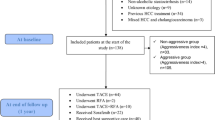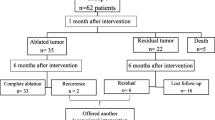Abstract
Background
Cytokeratin is associated with the recurrence and metastasis of some cancers and tends to increase the malignancy of the disease. It is getting more and more attention in cancer research. Abnormal expression of cytokeratin 19 (CK19) has been reported as an important prognostic factor in cancers. CK19 is a marker of bile duct cells, liver progenitor cells (HPCs), and early hepatoblasts, and its expression is associated with poor prognosis in patients diagnosed with hepatocellular carcinoma (HCC). The purpose of this study was to evaluate the predictive value of CK19 for tumor recurrence after radical resection in patients with hepatitis B virus (HBV) positive HCC.
Methods
This study was a retrospective study conducted in two institutions. A total of 674 patients with HBV positive HCC who underwent radical HCC resection from January 2010 to May 2020 were included in this study. Chi-square test or Fisher’s exact test was used to compare the classification variables and continuous variables were compared by t-test or Wilcoxon rank sum test. Cox regression model was used for univariate and multi-variable survival analyses. Based on the results of the multi-variable analyses of Cox regression, the nomogram of 2-year recurrence-free survival (RFS) was plotted. The model was validated internally in the Hangzhou cohort (training set) and then externally in the Lanzhou cohort (test set) and the effectiveness of the model was tested.
Results
For all 674 patients, 223 cases (33.1%) were positive and 451 cases (66.9%) were negative for CK19. The 2-year RFS rate was higher in patients with CK19 negative than in patients with CK19 positive. In the training set, correlation analysis showed that CK19 expression was correlated with preoperative potassium (P value(P) = 0.030), satellite nodules (P < 0.001) and microvascular invasion (P = 0.020). In the test set, CK19 expression was correlated with postoperative platelet (P = 0.038), satellite nodules (P = 0.003), microvascular invasion (P = 0.011), and maximum tumor size (P = 0.039). Univariate Cox regression correlation analyses showed that CK19 expression was correlated with preoperative potassium (P value(P) = 0.030), satellite nodules (P < 0.001), and microvascular invasion (P = 0.020). Training and test sets showed that postoperative platelet (> 300/L), CK19, satellite nodules in the training set, microvascular invasion, maximum tumor size, and tumor boundary were adverse factors for predicting RFS. Multi-variable analyses showed that in the training set, postoperative platelet > 300/L (hazard ratios (HR) = 2.753, 95% confidence interval (95%CI):1.234–6.142, P = 0.013), CK19 (HR = 1.410, 95%CI:1.006–1.976, P = 0.046), satellite nodule (HR = 1.476, 95%CI:1.026–2.120, P = 0.036), microvascular invasion (HR = 2.927, 95%CI:2.006–4.146, P < 0.001), incomplete tumor capsule (HR = 1.539, 95%CI:1.012–2.341, P = 0.044) were independent prognostic indicator of poor RFS. In the test set, postoperative platelet > 300/L (HR = 2.816, 95%CI:1.043–7.603, P = 0.041), CK19 (HR = 1.586, 95%CI:1.016–2.475, P = 0.042), satellite nodule (HR = 1.706, 95%CI:1.067–2.728, P = 0.026), microvascular invasion (HR = 1.611, 95%CI:1.034–2.510, P = 0.035), and tumor without capsule (HR = 1.870, 95%CI:1.120–3.120, P = 0.017) were independent prognostic indicators of poor RFS. The C-index for the nomogram was 0.698 (95%CI: 0.654–0.742) and the C-index for the test set was 0.670 (95%CI: 0.616–0.724). Both internal and external verification showed good results in identification and calibration.
Conclusion
CK19 plays a key role in tumor malignancy through overexpression and the expression of CK19 is an independent adverse factor affecting recurrence; therefore, CK19 can be used as a potential biomarker to predict adverse prognosis after surgery and adjuvant therapy in HCC patients.





Similar content being viewed by others
References
Nagtegaal, I.D., R.D. Odze, D. Klimstra, et al., The 2019 WHO classification of tumours of the digestive system[J]. Histopathology, 2020. 76(2): p. 182-188.
Llovet, J.M., R.K. Kelley, A. Villanueva, et al., Hepatocellular carcinoma[J]. Nat Rev Dis Primers, 2021. 7(1): p. 6.
Yang, J.D., P. Hainaut, G.J. Gores, et al., A global view of hepatocellular carcinoma: trends, risk, prevention and management[J]. Nat Rev Gastroenterol Hepatol, 2019. 16(10): p. 589-604.
T. Akinyemiju, S. Abera, M. Ahmed,et al., The burden of primary liver cancer and underlying etiologies from 1990 to 2015 at the global, regional, and national level: Results from the global burden of disease study 2015[J]. JAMA Oncol, 2017. 3(12): pp. 1683–1691.
Yang, J.D. and J.K. Heimbach, New advances in the diagnosis and management of hepatocellular carcinoma[J]. BMJ, 2020. 371: p. m3544.
Llovet, J.M., A. Villanueva, A. Lachenmayer, et al., Advances in targeted therapies for hepatocellular carcinoma in the genomic era[J]. Nat Rev Clin Oncol, 2015. 12(7): p. 408–24.
Merle, P., The New Immuno-Oncology-Based Therapies and Their Perspectives in Hepatocellular Carcinoma[J]. Cancers, 2021. 13(2): p. 238.
Ang, S.F., E.S. Ng, H. Li, et al., The Singapore Liver Cancer Recurrence (SLICER) Score for relapse prediction in patients with surgically resected hepatocellular carcinoma[J]. PLoS One, 2015. 10(4): p. e0118658.
Kim, M.A., H.S. Lee, H.K. Yang, et al., Cytokeratin expression profile in gastric carcinomas[J]. Hum Pathol, 2004. 35(5): p. 576–81.
Apaydin, R., Y. Gurbuz, D. Bayramgurler, et al., Cytokeratin contents of basal cell carcinoma, epidermis overlying tumour, and associated stromal amyloidosis: an immunohistochemical study[J]. Amyloid, 2005. 12(1): p. 41-7.
R. Shaw., A. Christensen., K. Java., et al., Intraoperative sentinel lymph node evaluation: implications of cytokeratin 19 expression for the adoption of OSNA in oral squamous cell carcinoma[J]. Ann Surg Oncol, 2016. 23(12):p.4043–4048.
Xu, E.S., M.H. Yang, C.Y. Liu, et al., Decreasing cytokeratin 17 expression in head and neck cancer predicts nodal metastasis and poor prognosis: The first evidence[J]. Clin Otolaryngol, 2018. 43(4):p.1010–1018.
Mehrpouya, M., Z. Pourhashem, N. Yardehnavi, et al., Evaluation of cytokeratin 19 as a prognostic tumoral and metastatic marker with focus on improved detection methods[J]. J Cell Physiol, 2019. 234(12): p. 21425–21435.
Jain., R., S. Fische., S. Serra., et al., The Use of Cytokeratin 19 (CK19) Immunohistochemistry in Lesions of the Pancreas, Gastrointestinal Tract, and Liver[J]. Appl Immunohistochem Mol Morphol 2010. 18: p. 9-15.
Kato, J., T. Hida, S. Sugita, et al., Cytokeratin 19 expression is a risk factor for metastasis in cutaneous squamous cell carcinoma[J]. J Eur Acad Dermatol Venereol, 2018. 32(7): p. e299-e301.
Oezkan, F., A.M. Khan, T. Hager, et al., OSNA: A Fast Molecular Test Based on CK19 mRNA Concentration for Assessment of EBUS-TBNA Samples in Lung Cancer Patients[J]. Clin Lung Cancer, 2016. 17(3): p. 198-204.
Govaere, O., M. Komuta, J. Berkers, et al., Keratin 19: a key role player in the invasion of human hepatocellular carcinomas[J]. Gut, 2014. 63(4): p. 674-85.
Zhuo, J.Y., D. Lu, W.Y. Tan, et al., CK19-positive Hepatocellular Carcinoma is a Characteristic Subtype[J]. J Cancer, 2020. 11(17): p. 5069-5077.
Lee, J.I., J.W. Lee, J.M. Kim, et al., Prognosis of hepatocellular carcinoma expressing cytokeratin 19: comparison with other liver cancers[J]. World J Gastroenterol, 2012. 18(34): p. 4751-7.
Yang, X.R., Y. Xu, G.M. Shi, et al., Cytokeratin 10 and cytokeratin 19: predictive markers for poor prognosis in hepatocellular carcinoma patients after curative resection[J]. Clin Cancer Res, 2008. 14(12): p. 3850-9.
Uenishi., T., S. Kubo., Tanaka., et al., Cytokeratin 19 expression in hepatocellular carcinoma predicts early postoperative recurrence[J]. Cancer Sci 2003. 94(10): p. 851-857.
Yang, Y., H. Nagano, H. Ota, et al., Patterns and clinicopathologic features of extrahepatic recurrence of hepatocellular carcinoma after curative resection[J]. Surgery, 2007. 141(2): p. 196-202.
Ochiai, T., H. Ikoma, K. Okamoto, et al., Clinicopathologic features and risk factors for extrahepatic recurrences of hepatocellular carcinoma after curative resection[J]. World J Surg, 2012. 36(1): p. 136-43.
Schweizer, J., P.E. Bowden, P.A. Coulombe, et al., New consensus nomenclature for mammalian keratins[J]. J Cell Biol, 2006. 174(2): p. 169-74.
Kaliszewski., K., M. Rzeszutko., B. Wojtczak., et al., Expression of cytokeratin-19 (CK19) in the classical subtype of papillary thyroid carcinoma: the experience of one center in the Silesian region[J]. Folia Histochem Cytobiol, 2016. 54(4): p. 193-201.
Chu., P.G., R.E. Schwarz., S.K. Lau., et al., Immunohistochemical staining in the diagnosis of pancreatobiliary and ampulla of vater adenocarcinoma application of CDX2, CK17, MUC1, and MUC2[J]. Am J Surg Pathol, 2005. 29(3): p. 359–367.
Jung, M., B. Kim, and K.C. Moon, Immunohistochemistry of cytokeratin (CK) 5/6, CD44 and CK20 as prognostic biomarkers of non-muscle-invasive papillary upper tract urothelial carcinoma[J]. Histopathology, 2019. 74(3): p. 483-493.
MJ., H., S. EA., C. YW., et al., Role of intermediate filaments in migration, invasion and metastasis[J]. Cancer and Metastasis Reviews, 1996. 15: p. 507-525.
Kim, H., G.H. Choi, D.C. Na, et al., Human hepatocellular carcinomas with "Stemness"-related marker expression: keratin 19 expression and a poor prognosis[J]. Hepatology, 2011. 54(5): p. 1707-17.
Ding, S.J., Y. Li, Y.X. Tan, et al., From proteomic analysis to clinical significance: overexpression of cytokeratin 19 correlates with hepatocellular carcinoma metastasis[J]. Mol Cell Proteomics, 2004. 3(1): p. 73-81.
Author information
Authors and Affiliations
Corresponding author
Ethics declarations
Ethics Approval
All procedures performed in studies involving human participants were in accordance with the ethical standards of the institutional and/or national research committee, with the 1964 Helsinki Declaration and its later amendments, or comparable ethical standards. This article does not include any animal research conducted by the authors.
Informed Consent
Informed consent was obtained from all the individual participants that were included in the study.
Conflict of Interest
The authors declare no conflict of interest.
Additional information
Publisher’s note
Springer Nature remains neutral with regard to jurisdictional claims in published maps and institutional affiliations.
Wei Shuyao and Bao Mingyang contributed to the work equally and should be regarded as co-first authors.
Rights and permissions
About this article
Cite this article
Shuyao, W., Mingyang, B., Feifei, M. et al. CK19 Predicts Recurrence and Prognosis of HBV Positive HCC. J Gastrointest Surg 26, 341–351 (2022). https://doi.org/10.1007/s11605-021-05107-w
Received:
Accepted:
Published:
Issue Date:
DOI: https://doi.org/10.1007/s11605-021-05107-w




